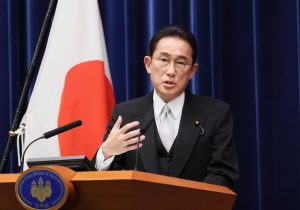Last month Japan’s new Prime Minister Kishida Fumio unveiled a record-breaking economic stimulus package to rebuild Japan’s COVID-19 battered economy. But shortly after, Japan once again closed its borders to new arrivals in response to the spread of Omicron, signaling that COVID-19 countermeasures take priority over economic normalization. It raises questions over how effective the latest economic measures will be in rejigging the economy amid the pandemic’s unpredictable trajectory.
On December 6, Kishida delivered his second policy speech to the public, which shed more light on the $490 billion stimulus plan. It features four pillars of growth: science and innovation, digital technology, economic security, and climate change. Kishida described the measures as “sufficient in scale and content to deliver reassurance and hope to the people.”
During the LDP leadership election in October, Kishida vowed to usher in a “new form of capitalism” with plans to speed up income redistribution and promote a “virtuous cycle of growth.” The economic stimulus centers around driving up wages in the private sector to achieve wealth distribution and long-term growth. Kishida said he would do whatever it takes to raise wages and stressed that higher wages are essential to protecting the Japanese economy from rising global prices such as soaring crude oil.
The government aims to build momentum for a 3 percent wage increase in the nursing and childcare sector by offering tax breaks of up to 40 percent to small and medium businesses and 30 percent for large companies. Starting from February, nurses will see an estimated 1 percent wage increase of 4,000 yen per month ($35). However, some analysts argue that wage growth in the nursing and childcare sector will not yield significant benefits from a macro perspective. The proposed tax deductions do not tackle Japan’s low labor productivity and will likely be short term and insufficient to lift wages overall, which have been stagnant for almost 30 years. There are also no policies targeting Japan’s severe labor shortage or steps to boost exports.
Kishida pledged to strengthen measures to tackle COVID-19 and revitalize the economy. But he stressed the importance of the order of recovery and the need to not make any mistakes. The previous Suga administration came under fire for its lagging and reactive policies, which failed to bring the pandemic under control during the country’s deadly summer peak. Kishida acknowledged that the decision to close the border for one month would attract criticism but pushed the need to anticipate a worst-case scenario to prevent an outbreak of Omicron as the number of COVID-19 infections plummets nationwide.
Vaccination is widely believed to be key to reopening and rebuilding the economy. Despite the initial slow rollout, Japan’s vaccination rate is now one of the highest in the world, at 79 percent of the entire population. Under the economic stimulus package, vaccine booster shots will be fast tracked and free PCR testing will be expanded along with the procurement of oral COVID-19 medication in preparation for a possible winter wave of infections.
As Europe and the United States show signs of recovery, Japan’s economy shrank last quarter at an annualized pace of 3 percent. Japan’s cautious approach to reopening is sending mixed messages, which are at odds with rebuilding consumer and businesses confidence and encouraging investment. Moreover, the appeal of tax incentives will also depend on whether companies’ profits return to a pre-pandemic level. Japan’s strict COVID-19 border closures have been criticized by business lobby group Keidanren, which argues that shorter quarantine for vaccinated temporary business travelers is key to social and economic normalization.
The government plans to deliver immediate relief to help struggling families and businesses affected by the pandemic. Low-income families will be eligible for an $880 handout to every child, divided between cash and coupons. After criticism that the administrative costs of coupons would cost more than a lump sum payment in cash, the government said it would make it possible for local municipalities to provide a full cash hand out depending on each local jurisdiction. Additionally, bars and restaurants that shortened business hours during the state of emergency and COVID-19 prevention restrictions will be eligible for a lump sum payment. The employment adjustment subsidy that pays businesses to keep staff will also be extended until March next year.
In terms of long-term recovery, Kishida has positioned supply chain resilience at the top of the economic security agenda. He pledged to invest 800 billion yen in developing domestic semiconductor production. In an effort to push regional revitalization, Kishida revealed a “digital garden city super highway” constructed with submarine cables to enable high-speed 5G communication, enabling an easier work life transition to regional areas. The project is expected to take three years to complete.
The economic stimulus package is a smorgasbord board of short-term aid to support businesses through the economic fallout of COVID-19 restrictions with long-term domestic industry investment geared toward a post-pandemic era. As Japan shifts its attention to preventing the spread of Omicron, concerns of a prolonged downturn will heighten anxieties. With consumption a precursor to economic growth, it is unclear how much of the incremental wage gains will go to spending.































